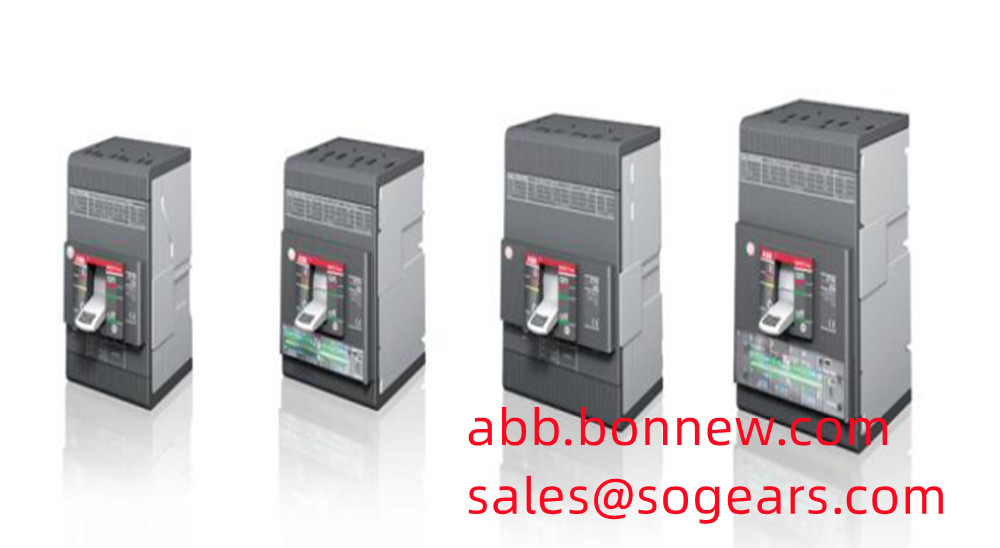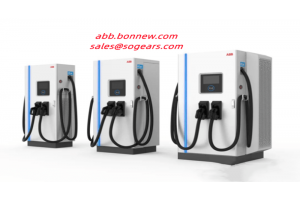
Some internationally renowned electrical companies began to develop a new generation of molded case circuit breakers in the mid-to-late 1990s. So far, the new generation of molded case circuit breakers has basically completed the replacement of old products. The comprehensive technical and economic indicators of the new generation of molded case circuit breakers have been greatly improved compared to the old products. The overall development idea is: to meet the needs of the entire power distribution system to the greatest extent, not to blindly pursue high indicators, and to consider the applicability, safety, reliability and economy of the system while improving the technical indicators. The new generation of molded case circuit breakers has a complete series of rated currents with adjustable rated currents. Together with frame circuit breakers, it can provide an overall solution for power distribution systems ranging from tens of amperes to several thousand amperes.
ABB's Tmax T4 has a rated ultimate short-circuit breaking capacity of up to 200 kA. The rated operating short-circuit breaking capacity Ics of most of the frame grades of the new generation of molded case circuit breakers is the same as the rated ultimate short-circuit breaking capacity Icu, which greatly improves the reliability of short-circuit breaking.

I.New double breakpoint contact system
The double-breakpoint contact system adds a breakpoint, strengthens the near-cathode effect of the short arc, and has a higher arc voltage, which can improve the short-circuit breaking capacity. The system avoids soft connection or rotatable conductive connection in mechanical structure, improves mechanical and electrical reliability, and has been widely used in the new generation of molded case circuit breakers.
The new double-breakpoint contact system generally adopts a rotary structure, and the fork-type double-breakpoint structure was also adopted in the early days. From a structural point of view, the torque generated by the repulsive force of the two breakpoints of the fork structure is asymmetrical, and the rotational frictional resistance is relatively large. Under the same conditions, the breaking speed is not as fast as that of the rotary structure. At the same time, the isolation of the arc extinguishing chamber between the two breakpoints of the fork structure is also difficult to achieve, and it is not easy to use the air pressure principle to improve the arc blowing capacity. Therefore, ABB also adopted the rotary double breakpoint structure when designing Tmax T4, T5 and T6.
II.Moving contact stuck mechanism
Molded case circuit breakers generally use the principle of current-limiting breaking, which uses the electric force generated by the short-circuit current flowing through the contacts to quickly repel the contacts, introduce arcs, and limit the rise of the short-circuit current. In order to prevent the contacts from re-closing when the AC current crosses zero, some circuit breakers have specially designed a blocking mechanism for the contacts to open, so that the contacts are stuck in the open position after the contacts are opened, and the blocking mechanism is not blocked until the operating mechanism moves. Unlock. The contact clamping mechanism and the fast-acting operating mechanism are used to control the breaking speed of the circuit breaker within a few milliseconds, which greatly improves the breaking speed.
III.Closed contact arc extinguishing system The contact arc extinguishing system of the new generation of molded case circuit breakers basically adopts a closed design structure. The moving and static contacts and the arc extinguishing chamber are sealed together with arc-resistant plastic materials to form a closed formula structure. The new generation of molded case circuit breakers has two enclosed structures:
- The three-pole contact arc extinguishing system is enclosed in a housing, but each pole is completely separated, such as Moeller's NZM3.
- The contact arc extinguishing system of each pole forms a unit separately.
Compared with the open structure, the closed contact arc extinguishing system has the following advantages:
- Prevent the metal particles generated during short-circuit breaking from splashing on the operating mechanism, causing the mechanism to be stuck or annealing the moving and static contact springs.
- Prevent the arc from blowing back and cannot enter the arc extinguishing chamber, which affects the short-circuit current breaking.
- The powerful airflow formed by the pressure generated by the arc in the closed space is used to accelerate the cooling and spraying of the arc, so that the arc is quickly extinguished.
- Use the strong airflow generated by the arc to accelerate the contact repulsion, or hit the tripping lever to make the mechanism move quickly to accelerate the arc extinguishing. The closed contact arc extinguishing system not only improves the short-circuit breaking capacity, but also can achieve Icu=Ics, which improves the reliability of short-circuit breaking.
IV.Application of electronic trip unit in the new generation of molded case circuit breaker The electronic trip unit is a combination of microelectronics, computer and communication technology, and has the incomparable advantages of traditional thermal magnetic trip units.
For example: stable tripping characteristics, not affected by ambient temperature and climate; high accuracy of tripping current and time; adjustable setting current, and different characteristic curves can be set to meet the requirements of various load protection; electronic tripping The controller can derive communication functions, realize networked control, and also derive auxiliary functions such as regional interlocking, power monitoring and power analysis. The new generation of molded case circuit breakers of various companies can be equipped with electronic trip units, and gradually develop to small-capacity rated current frames of 160 A and below.
Due to economic reasons, at present, most of the company's molded case circuit breakers with a frame current of 160 A and below still use an adjustable thermal-magnetic release; the frame current of 250 A and above can be installed with an electronic release or a thermal-magnetic release. circuit breakers; large-capacity molded case circuit breakers with a frame current of 630 A or more than 800 A are generally designed to only install electronic trip units, but circuit breakers used in DC circuits still use thermal Magnetic release (such as ABB's TmaxT5 and T6 and Schneider's NS series, etc.).
In recent years, there has been a new development in the electronic release technology of molded case circuit breakers. ABB has launched the PR223EF, an electronic controller beyond area selectivity, which perfectly combines the current limiting performance and selectivity of molded case circuit breakers.
PR223EF can be installed on molded case circuit breakers of 250-800 A frame frame, the controller adopts Early Fault Detection and Blocking (EFDP) algorithm in the circuit to achieve fast zone interlocking, and can predict short-circuit current early within 300μs , and combined with the fast driving and breaking mechanism of the circuit breaker (the breaking time of the Tmax series is below 5 ~ 6 ms), the total tripping and interlocking time provided by the PR223EF is about 10 ms, so the molded case circuit breaker equipped with the PR223EF The device can achieve selectivity in the current range of 100 kA and below.

V.Communication Molded Case Circuit Breaker
The new generation of molded case circuit breakers using electronic trip units can derive communication functions to realize network control. Communication generally uses a separate communication adapter (or data management interface) to connect with the communication system. For example, Siemens VL series can be connected with computer through circuit breaker data adapter (BDA), connected with Ethernet through enhanced data adapter (BDA Plus), and connected with Profibus field bus through COM10Profibus module. Large companies often implement their own protocols when connecting communicable circuit breakers to fieldbus systems. Small and medium-sized companies do not have the ability to independently develop protocols, so they use public protocols of large companies or bus organizations.
For example, Moeller's NZM series molded case circuit breaker uses a data management interface (DMI) and an interface module to connect with the bus system. DMI can display the measured current, fault current and circuit breaker status, etc. By replacing different interface modules, NZM can be connected with different bus systems such as Profibus and DeviceNet. The communication mode of the communication adapter used by the SA and CM1 series of molded case circuit breakers in my country is similar to the communication connection module used by Moeller. Circuit breaker is an economical, practical and flexible system access method, and is gradually recognized by small and medium-sized enterprises.
VI.Modular structure design
The structure of the new generation of molded case circuit breakers generally adopts a modular design. In addition to the closed contact system, the overcurrent release also generally adopts a modular design. The thermal magnetic release or the electronic release are designed with replaceable release modules, and the release can be easily replaced without opening the cover to meet the needs of various users and reduce manufacturing costs.
VII.Expansion and Standardization of Annexes
The new generation of molded case circuit breakers offers a wealth of internal and external accessories. The internal accessories all adopt the box structure, the user can replace the internal accessories without opening the cover, the installation is convenient, flexible and safe. Internal accessories tend to be standardized. In addition to the usual electric operating mechanisms, plug-in mounting bases and various operating handles, some companies' external accessories also provide accessories such as busbar connection and installation integrated adapters and flexibly installed interlocking mechanisms. Meet the requirements of standardized design of distribution cabinets.
VIII.Ground fault protection function and residual current protection function The new generation of molded case circuit breakers using electronic release have ground fault protection function, and their characteristics are:
- Use an overcurrent transformer to detect the current signal.
- Use a microprocessor to process and calculate the current transformer signals of the phase line and the N line, and calculate the ground fault current. The ground fault operating current is 20% to 80% of the rated current, which is mainly used for the protection of phase line metallic ground faults.
The new generation of molded case circuit breakers can provide residual current protection, generally in two ways:
- Circuit breaker with twin structure. Represented by Japan's Mitsubishi, Fuji and other companies, the built-in residual current module is adopted. Molded case circuit breakers and residual current circuit breakers have exactly the same appearance and installation dimensions, so they are called twin circuit breakers. This type of residual current circuit breaker is small in size and easy to replace.
- Assembled residual current circuit breaker. Represented by European companies such as Siemens, ABB, Schneider, etc., residual current modules are assembled on molded case circuit breakers to form residual current circuit breakers. The residual current module is supplied as an external accessory of the molded case circuit breaker. The residual current module and the circuit breaker can be assembled vertically (installed at the bottom of the circuit breaker) or horizontally (installed on the bottom side of the circuit breaker). Most of the residual current circuit breakers derived from the new generation of molded case circuit breakers are vertically assembled. In addition to AC type and A type residual current modules, B type residual current modules that can detect smooth DC currents, such as ABB's RC223 and Moeller's RCD modules, have also been developed in recent years. The molded case circuit breaker of type B residual current protection can operate correctly under the condition of AC fault current (including 1kHz and below AC fault current), pulsating DC fault current and smooth DC fault current. ABB's B-type residual current circuit breaker can also set the sensitivity for AC fault current of various frequencies to meet the needs of different frequencies of use.
IX.Operating mechanism
The quick action of the operating mechanism is essential to improve the breaking capacity. Comprehensive analysis of the operating mechanisms of each company shows that the basic structure is still a link mechanism with spring energy storage, but improvements have been made in the following aspects to improve the breaking speed and mechanical life of the mechanism:
- Significantly lengthen the size of the jumping buckle rotation axis to the end point of the locking surface, especially greatly lengthen the jumping buckle rotation axis to the jumping buckle and connecting rod pin axis size, and at the same time appropriately increase the energy storage of the spring . Once the jumping buckle is released, in the process of converting from the four-bar linkage to the five-bar linkage, the angular velocity of the upper link rotating around the axis of the jumping buckle and the rotation of the upper link and the connecting pin of the jumping buckle is increased. At the same time, the lifting force of the connecting rod to the moving contact opening is greatly improved, and the breaking speed is significantly improved.
- By simplifying the shape of each component of the mechanism and adding process holes, the quality of parts such as jumping buckles and connecting rods is reduced as much as possible, the motion inertia of the mechanism is reduced, and the breaking speed is increased.
- Improve the manufacturing process, ensure the dimensional accuracy and matching accuracy of the components, reduce the friction force and tripping force of the sliding parts, and improve the tripping speed of the mechanism.
X.Using environmentally friendly materials, the new generation of molded case circuit breakers fully considers the protection of the environment in the entire process from design, manufacture to use, and prevents toxic and harmful substances from polluting the environment.
The shell and contacts of the circuit breaker are generally made of recyclable and environmentally friendly materials (for example, the shell is generally made of halogen-free flame-retardant thermoplastic material, and the contact is made of silver-based alloy material that does not contain metal cadmium, etc.). In order to facilitate the recycling of resources, the type of material (such as PC, PA, etc.) is marked with a molded mark on the larger plastic parts such as the shell, so that the material can be classified and recycled during recycling. Except for the exposed conductive parts that still use electroplating coating, other internal conductive parts generally use bare copper as much as possible to reduce the pollution of electroplating to the environment.




